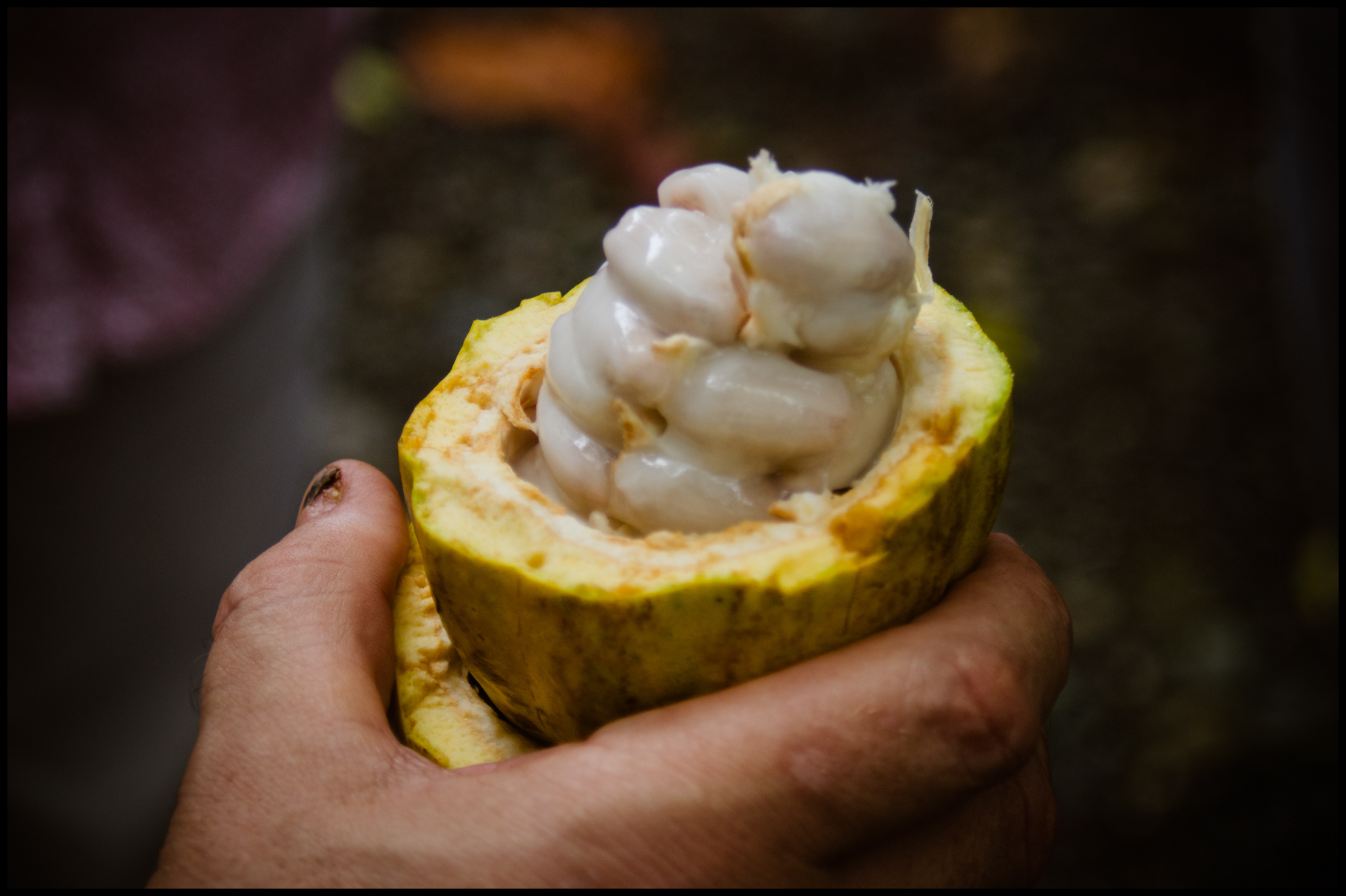“Happiness. Simple as a glass of chocolate or tortuous as the heart. Bitter. Sweet. Alive.”
Joanne Harris, Chocolat
It’s only 6am but I’ve been awake for a while now. As the first rays of sun touch down through the jungle canopy overhead, the sounds of roosters crowing, dogs barking, squirrels chattering, tropical birds twittering and howler monkeys, well howling, fills the morning air.
It’s a cacophony of life out there just beyond our front porch. I’ve put on some good Costa Rican coffee and the coffee maker is now adding it’s belaboured little gurgles to the morning symphony, indicating that it’s time for me to update you on my adventures.
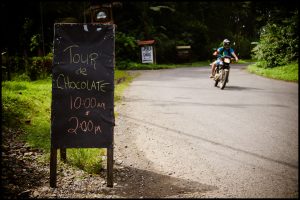
This week Emrys and I checked out a Chocolate Tour just outside of Puerto Viejo, Costa Rica. We meet up with our tour guide Paul at his coffee shop, Caribeans Coffee & Chocolate, which is just off the coastal highway, at the base of a cacao farm on which he grows and produces bean to bar artisanal chocolate. After we pay the tour fee, use the washrooms one last time and apply some bug spray we are ready to head out on the tour.
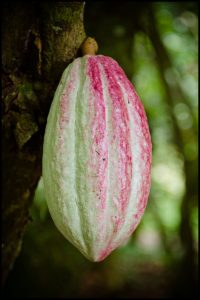
Photo by EPH Photography
As we walk the path behind the coffee shop, up into the steep hillside of the cacao farm, Paul tells us a little bit about the history of cacao in the region. We learn that the cacao beans were once used as currency by the indigenous people, how the value of cacao was discovered by the Europeans, how it became a cash crop. Like most cash crops the cacao industry was rife with exploitation and then in 1979 a blight swept the countryside reducing cacao production by 95%. By the time the blight issue was sorted many farmers had gone out of business and/or the land had been converted to grow the more profitable banana. It is only in recent years that there has been a real resurgence in the production of artisanal chocolate in the region.
Our tour guide Paul came to Costa Rica doing volunteer work and developed an interest in roasting his own coffee, eventually leading to him opening his coffee shop. When a friend asked him how they might add value to the property (an old cacao farm) on which the coffee shop sat, Paul became curious about cacao. He started experimenting with cacao, much as he had with coffee beans before. He purchased cacao from other local farmers and through a process of trial and error (and extensive googling) he managed to produce a very small quantity of very fine chocolate. He soon realized that if he wanted to make the farm truly productive he needed to bring in some knowledgeable, old school cacao farmers to work the land and to teach him everything they knew about cacao; and so that is what he did.
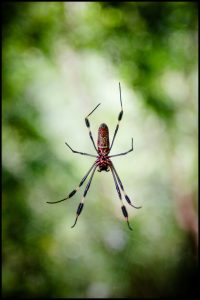
Photo by EPH Photography
As we make our way up the hill, it’s getting hot out despite the jungle canopy overhead, which Paul has purposefully left intact to protect the ecology of the area. The cacao tree is a shade tolerant, moisture loving, understory rainforest tree. The tree has smooth bright green leaves and the cacao fruit sprouts improbably from the trunk of the tree, rather than the branches. As I look out through the cacao forest my eyes slowly focus and I realize that the trees around us are filled with hundreds of giant golden orb spiders. While Paul assures us they aren’t dangerous, and are an important part of the ecology, they are seriously freaking me out. I stick to the middle of the road and send Emrys on ahead to sweep any potential webs blocking the path.
We stop half way up the hill and Paul breaks open a cacao pod he’s been carrying with him. The inside looks viscous, a little like creamy white brains. He tells us to take a bean from the pod and suck on it, to taste the white fruit that surrounds each bean. I cautiously remove a bean and tentatively lick it. I am surprised by the flavour. It is citrusy, sweet and tart; almost like a Sweet Tart. It’s quite enjoyable if texturally off-putting. We learn that this tasty fruit is the part of the cacao that the squirrels enjoy, breaking open the pod and ruining the cacao for the farmer. In fact, squirrels have been a real problem on this farm and while many people have suggested trapping or poisoning the squirrels Paul refuses. It is important to him to maintain the ecology of the area, with all of the animals that inhabit it. He is however quite happy when we spot a giant black snake moving from tree to tree in the canopy overhead, as snakes like these help keep the squirrel population in check.
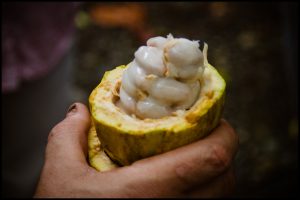
Photo by EPH Photography
As we make our way up the hill, we talk a little about what kind of chocolate we each enjoy and what sort of chocolate is commonly produced and sold. We learn about the differences between mass produced chocolate vs artisanal chocolate. One of the main differences being the way the big companies pay the farmers very little and ship the raw product great distances to process. The big companies also buy all kinds of different cacao of varying qualities, mix it all together and homogenize it through a process known as dutching, which is essentially treating the chocolate with an alkalizing agent to modify it’s colour. While this process makes the chocolate easier to work with it also removes as much as 60-90% of the beneficial antioxidants.
Paul’s farm on the other hand pays its workers a generous wage; which is possible in part because they create a value added product on site, that they sell locally, cutting out the middle man and the cost of shipping and distribution. But the main difference is in how they treat the cacao itself. Unlike the big companies, they keep cacao from different areas separate, working with each batch to bring out its unique qualities. After a process of picking, fermenting, drying, roasting, winnowing, grinding, tempering and moulding, this little farm produces a value added final product that rivals (and likely exceeds) that of the big producers.
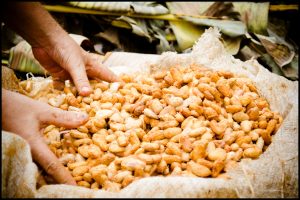
Photo by EPH Photography
We’re at the top of the hill now and checking out the little building where they break the pod open, scoop out the beans and fruit and place it in big wooden boxes to ferment. Paul shows us a pile of beans that are currently fermenting, which is incredibly hot to the touch and covered in tiny ants. This is the natural process, which is done instead of dutching. This fermentation brings out complex flavours in the bean and is one of the factors separating the artisanal chocolate from mass produced products.
Following the trail we end up at a beautiful veranda that over looks the jungle canopy and the Caribbean sea beyond. There is a welcome breeze coming in off the water and Paul’s wife is there. She hands us glasses of cool water and we have a seat and prepare to sample some of the chocolate they produce. We start with 4 selections of pure chocolate (just cacao and sugar, no flavours added), each of which is named for the local producer. We talk about what we taste. Not unlike wine, some are more astringent than others, some have hints of tropical fruit and others honey, some have a smooth mouth feel, others less so, some flavours fade away while others leave distinct aftertastes. It’s amazing just how different they are. Paul explains that some of the differences are inherent to the tree or particular grove, some come out in the fermenting, other flavours come out in the way the cacao is roasted.
Next we have a warm chocolate drink (just melted chocolate, honey, water and some spices), reminiscent of an Aztec ceremonial drink. Paul talks about how chocolate should be a savoured, social experience, not gulped down in secrecy with guilt. He says a traditional Caribbean blessing, wishing us health and happiness and we sip the warm cacao drink. The drink is amazingly good and quite unlike hot chocolate.
Finally, Paul’s wife reveals a table covered in spices, herbs, nuts and chocolate samples and we get to try our hand at combining flavour elements to create our own custom chocolate of sorts. I particularly enjoy the combination of chocolate and thyme.
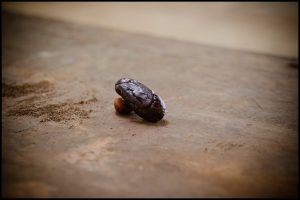
Photo by EPH Photography
Next we head over to the building where the beans are dried, roasted, winnowed, ground, tempered and poured into moulds and Paul takes us through each of the steps in brief. The set up is decidedly rustic as Paul has utilized shop vacuums, drills and all sorts of odds and ends to macgyver his version of what the big chocolate producers use. We get to see and taste the bean at various different stages. The dried and unroasted bean is surprisingly delicious and flavourful and a teaspoon covered in liquid chocolate is divine.
Soon it’s time to head down the hill, back through the golden orb spider forest, to where we started, at the coffee shop. Along the way Paul points out interesting plants and talks about their plans to have guests come stay on the farm where they will be able to participate in making their own chocolate from harvest to finished product. Once back at Caribeans Coffee & Chocolate, we linger too long in the delightfully refrigerated tasting room, where we do some more sampling and choose select bars to bring home with us, including, among others, the Tequila Shot (dark chocolate with sea salt and lime leaves) and Three Kings (dark chocolate with cinnamon, cardamom and nutmeg).
Looking back, it was a great day of hiking and learning; of observing the plants and animals around us. I’ve definitely gained a new understanding of where my chocolate is coming from and I can’t help but think it will influence my choices going forward. Oh yes, and the amazing chocolate I bought; I can hardly wait to share it with my friends!


